Contributors report earning $0.08-$2.28 per month, while some of the best-sellers yield $87.7 per month (aggregated in 2022). With a literally over 1000 times difference between average and best-seller content it’s easy to see that full earnings picture cannot be reduced to a single number. If you add videos to the mix, with a lower average of $0.24 per clip per month, calculations become even harder.
In this statistics-heavy post, I’ll be digging deep into case-studies of microstock contributors, starting from their first uploads, and provide you with useful tips/resources to get you well on your way to earning from your content! Additionally you can use a calculator to estimate your earnings too.
The good old days are truly over
Before we even begin to talk about the present-day, it’s important to highlight that if you’re getting started now, you’d going into an already 20-year-old mature industry. With hindsight, if you had the vision to start at its infancy or shortly after, you’d expect to earn considerably more even on lower-quality content. I started somewhat late in 2013 and managed to just about take advantage of the tail-end of some of the better days.
To illustrate just how drastically different the industry was, in 2009, Tyler Olson conducted a Microstock survey of 244 contributors with an average portfolio of 1,156 images spread out at multiple agencies. The average revenue for the year prior for each of those contributors was $10,077, which corresponds to $8.72 / image / year. Unsurprisingly, many of those contributors were full-time Microstockers and actually earning a living.
Determining factors for the steep earnings drop
If a similar survey was carried out today the average results would likely be closer to 15%, at an industry average of just $1.00 / image / year (not taking best-sellers into account). Therefore, few contributors would be able to earn a full-time income unless they happen to live in ultra-low-cost locations, such as Thailand where many Microstockers are actually living.
The catalysts for such a drastic drop are numerous and complex, but mainly come down to three key factors:
-
An oversupply of images now available, far outstripping the demand. In 2009, Shutterstock boasted just over 11 million images, while in 2022 their collection has bloated to 135 million, thus potentially making it more difficult for buyers to find your images (among frankly, millions of spammy and junky content). Among the top-results, contributors also now face more competition from improved quality for certain niches;
-
Leading agencies are finding increasingly clever ways to reduce contributor royalties. Agencies often frame the contractual changes as “exciting news” announcements which are somehow beneficial to contributors in the long-run. The latest “exciting news” is that Shutterstock have purchased Pond5, potentially putting even more downward pressure on the footage side of the industry. Pond5 is one of the few agencies left where contributors could set their own prices; and
-
The rise of free-download sites, such as Unsplash and Pexels with naïve contributors all too willing to license their (sometimes quite high-quality) images as Creative Commons in return for “exposure”. Why would a buyer pay for an already inexpensive subscription when they can download a similar image for free?
Costs
Hiring models and other costs
However, one must always keep in mind the costs of hiring a model which can be substantial and would eat away at your already small profits. If you have access to interesting models and can brainstorm them doing interesting things, you’re miles ahead of most newbies.
This option is not always available to contributors and keep in mind that if you do choose to hire professional models, the costs can be substantial at $50/hour being the average which would cut deep into your already thin profits as a Microstocker. Otherwise, you can even take pictures of yourself using a tripod or even a drone. There are also other costs such as hiring locations (when applicable) and special lighting equipment.
Equipment costs
The following is my initial gear from back in 2013. Almost ten years on, I’m happy to say that I regularly use the below, thus it paid off investing in quality equipment.
| Item | Price |
|---|---|
| Nikon D8000 Full Frame | $1700 |
| Sigma 24-70mm F/2.8 | $800 |
| Sigma 10-20mm F/4-5.6 | $400 |
| Nikon AF-S 50mm F/1.8 G | $120 |
| Nikon remote release | $20 |
| Manfrotto 294 carbon tripod | $250 |
| Nikon SB-900 F speedlight | $350 |
| Total investments | approx. $3,280 |
You might not need all of the equipment listed above. Starting out with a camera and single lens can be good enough, at least initially. However, it is a good showcase of something that eventually will be handy in creating high quality content over time.
Thinking about your hourly rate
As this is a business after all, thinking about the time invested is crucial. Reiterating the 20 hours/week invested over the course of 12 months, you would invest a total of 960 hours. You can estimate the time investment you will make by multiplying that by your hourly rate, which, depending where you live, might be substantial or not. Keep in mind that earnings produced by these investment will be passively accumulating over time.
Case studies
Microstock contributors reporting their earnings
In a recent poll at MicrostockGroup forum, 18% of responders reported earning $100 or less monthly, while about 11% reporters mentioned earning $1000-1500 and almost 19% reported earning more than $2000. In total 150 people voted, however they did not disclose the size of their portfolio.
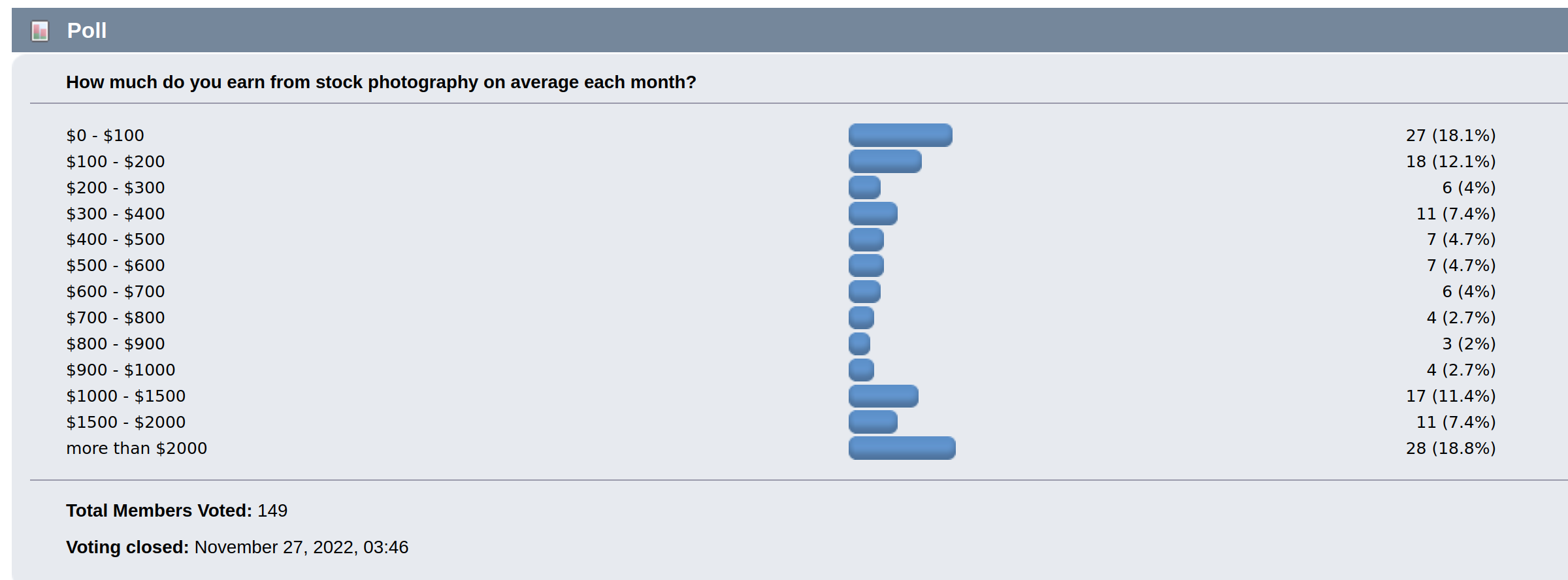
Microstock earnings poll (data from MicrostockGroup)
| Earnings | Responders |
|---|---|
| $0 - $100 | 27 (18.1%) |
| $100 - $200 | 18 (12.1%) |
| $200 - $1000 | 48 (32.2%) |
| more than $1000 | 56 (37.6%) |
There’s an obvious survivor’s bias here (those who failed to earn, didn’t vote), but still it paints an interesting picture.
Alexandre’s case: photos and footage
Using my own Microstock business as an example, one must keep in mind that I started in 2013 and the market was quite different then as discussed earlier. I wasn’t as meticulous as I am now in terms of tracking my monthly uploads, but I estimate the following number of uploads from 2013, hitting my stride in 2016:
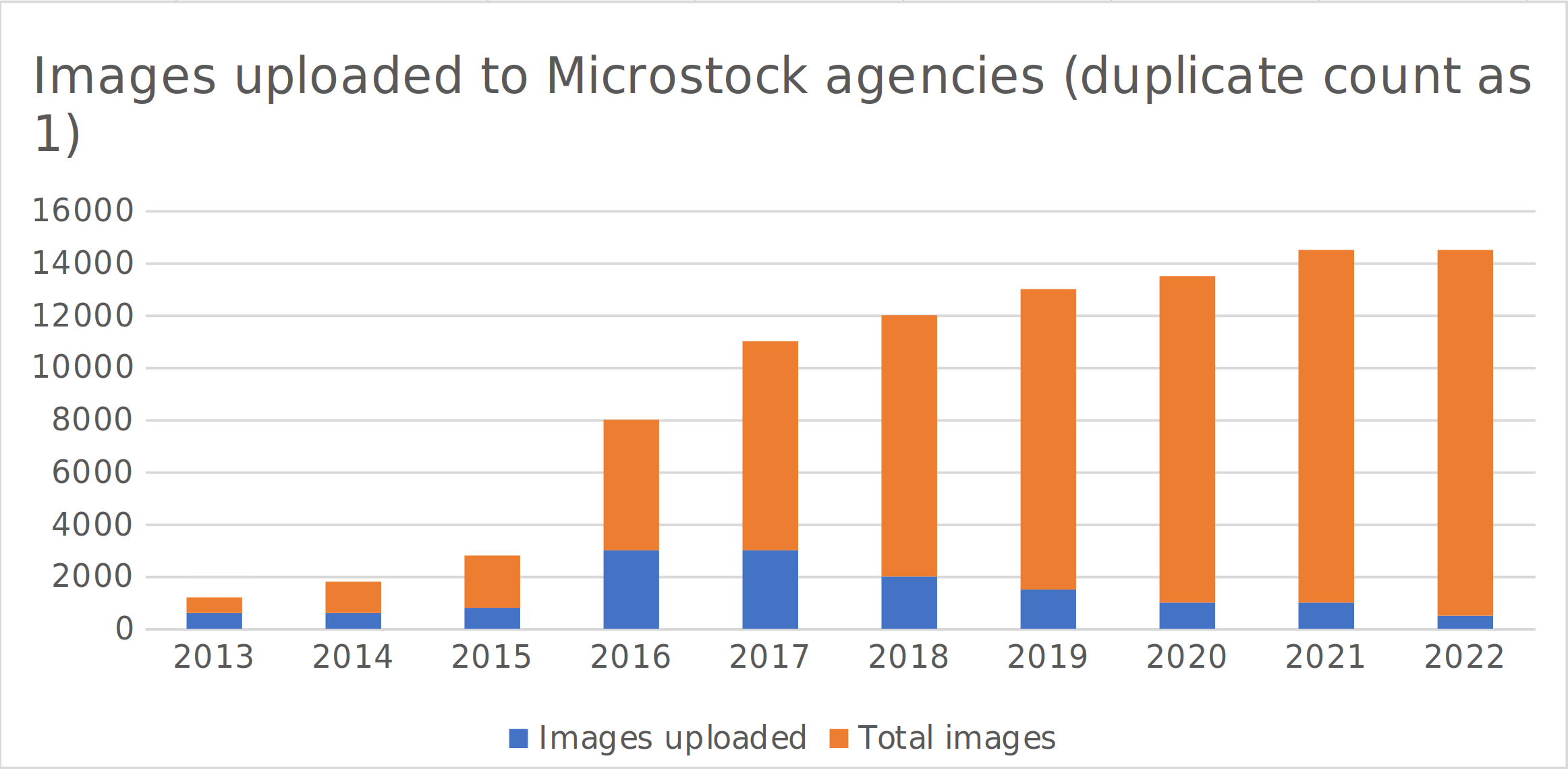
Number of images in the portfolio
As for footage, I started relatively late (better late than never), uploading slowly in 2017 and increasing my efforts hitting my stride in 2019:
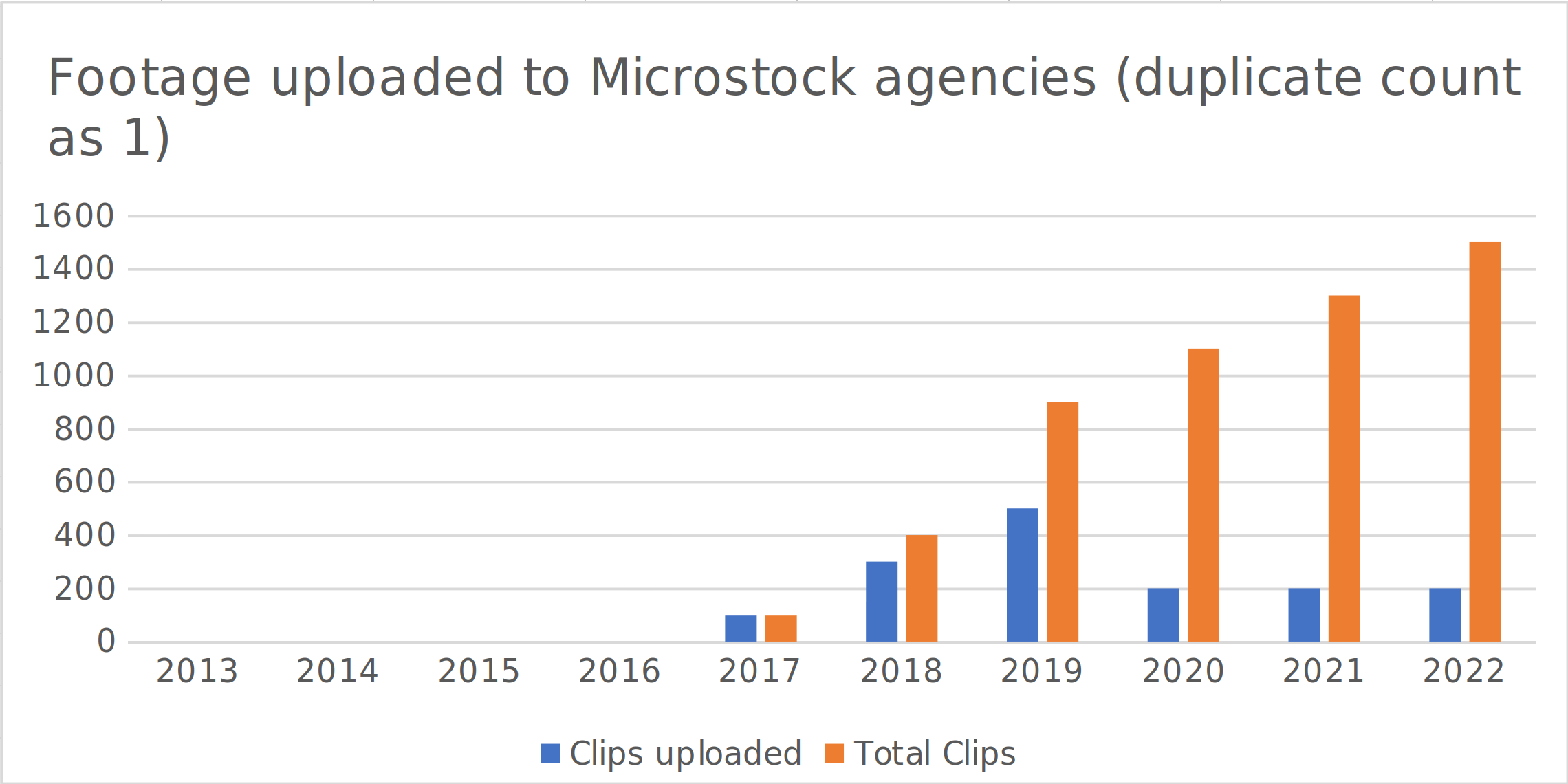
Number of videos in the portfolio
I regularly use Microstockr, a useful earnings tracking tool that I’m able to crunch some numbers to have a better understanding of which types of content sell best at which agencies.
The following are my earnings since 2013 (both stills and footage), with the peak occurring in pre-Covid 2019. So, it seems that I was rewarded for my massive efforts during my time living Italy in 2016-2018 with a fantastic earnings peak in 2019 just before the world went to nuts in 2020. Also, glad I started doing footage as it helped to increase my global earnings.
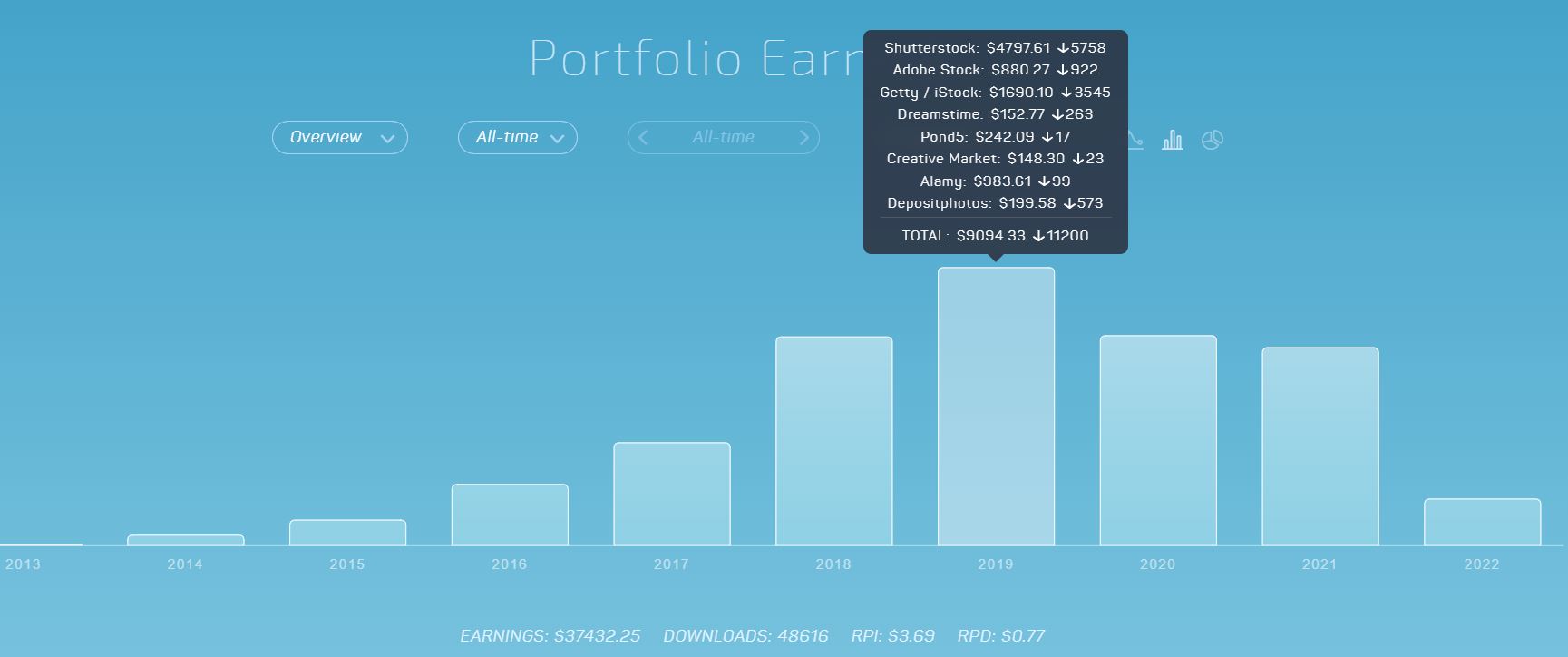
All-time earnings stats
Which types of assets sold best and why are beyond the scope of this article and will be discussed on a subsequent piece!
Steve Heap’s case
Steve Heap, from BackyardSilver, who also tracks earnings, has been regularly uploading since 2008 and has had more success on roughly a similarly sized portfolio. Here are his all-time earnings chart as posted on his 2021 earnings report. Steve has done a better job to accurately track his uploads and as you can see he began to hit his stride around 2013 and has kept going strong until the present-day:
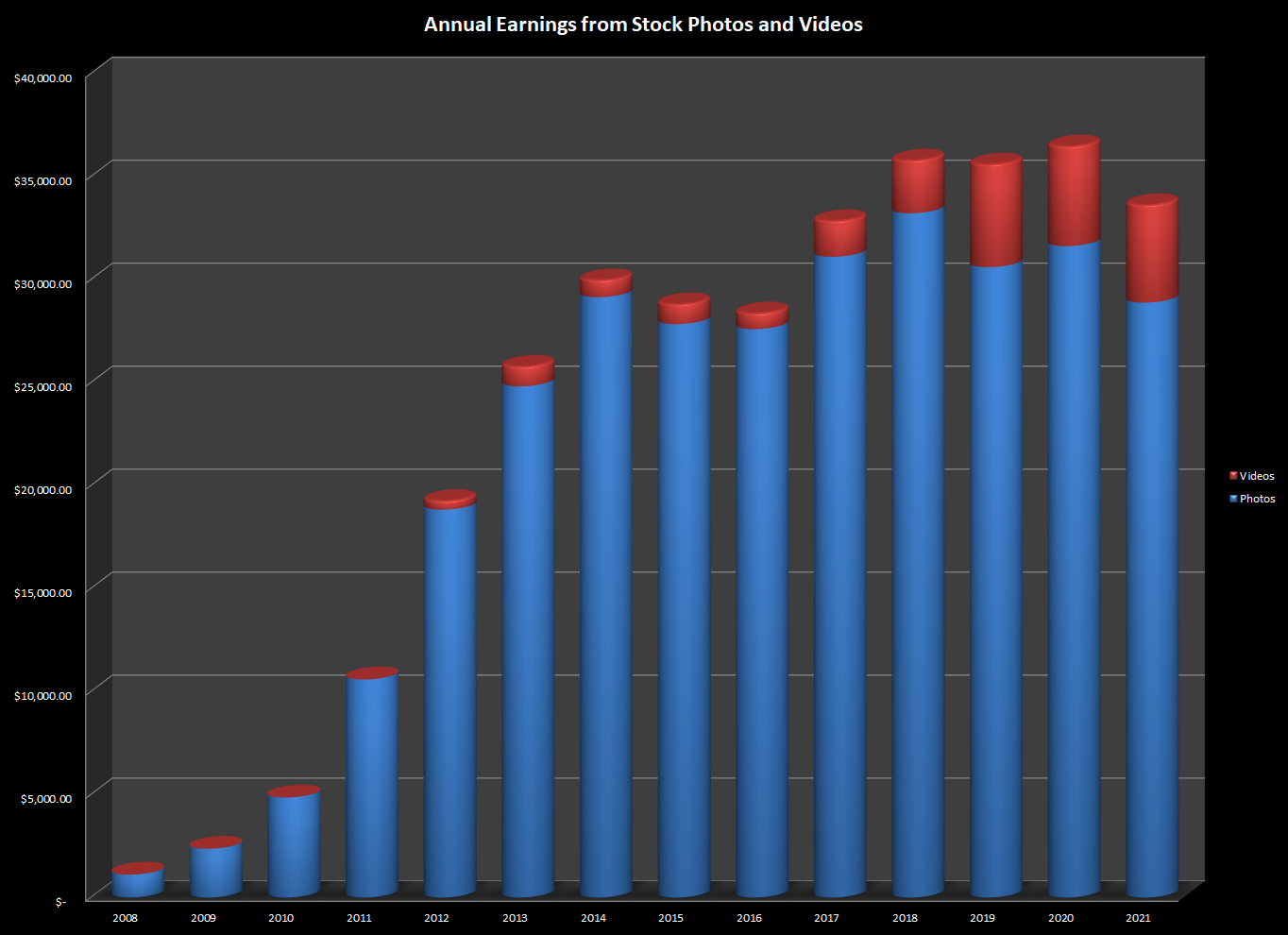
Growth in annual earnings till December 2021
As you can see from both historical charts, it generally takes a good 4-6 years to really get going to reach a “decent” amount of income while the assets take time to mature.
The following are the number of assets uploaded by Steve at three agencies from 2011.
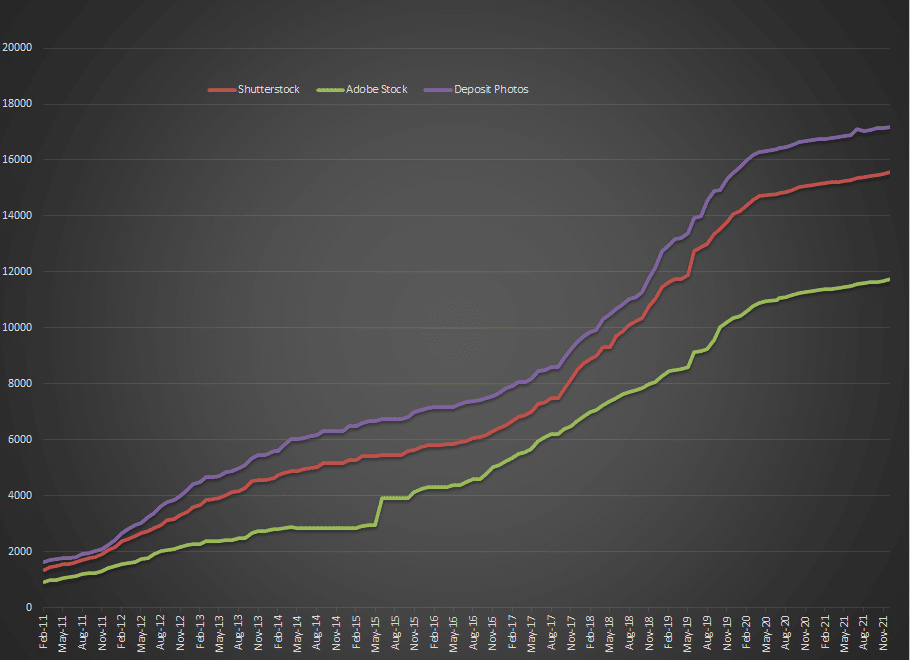
Growth in portfolio size till December 2021
Adam Melnyk’s case: drone footage
Adam Melnyk, interviewed at the Brutally Honest Blog, has come leaps and bounds in the past two years to capture some amazing and more importantly useful scenes for the Microstock market using his DJI Mavic drone. As a result of his efforts, Adam now regularly earns over $500/month that is equal to an average of $3.38 / per clip / year with regular sales at Shutterstock, Adobe Stock and Pond5. In a relatively short time, Adam has quite easily overtaken my Microstock earnings within his first three years with awesome footage.

Adam's drone videos (clickable)
Drones give you the option to capture some unique angles not normally available at stock sites. If you can combine the unique perspectives with a model, it may prove to be a strong-seller. However, it’s not as simple as buying and flying on the same day as you’ll need to be aware of your local/national regulations to avoid legal problems.
Taras’ case: a single photo
Best sellers are the workhorse of your portfolio. In the most extreme case, even a single photo can bring you as much as $6,314 as was discussed earlier in this blog which yields $87.7 / photo / month. Despite being a fully passive earner, such case has it’s end-of-life date, projected in about 10 years (for this specific photo) from it’s earnings:
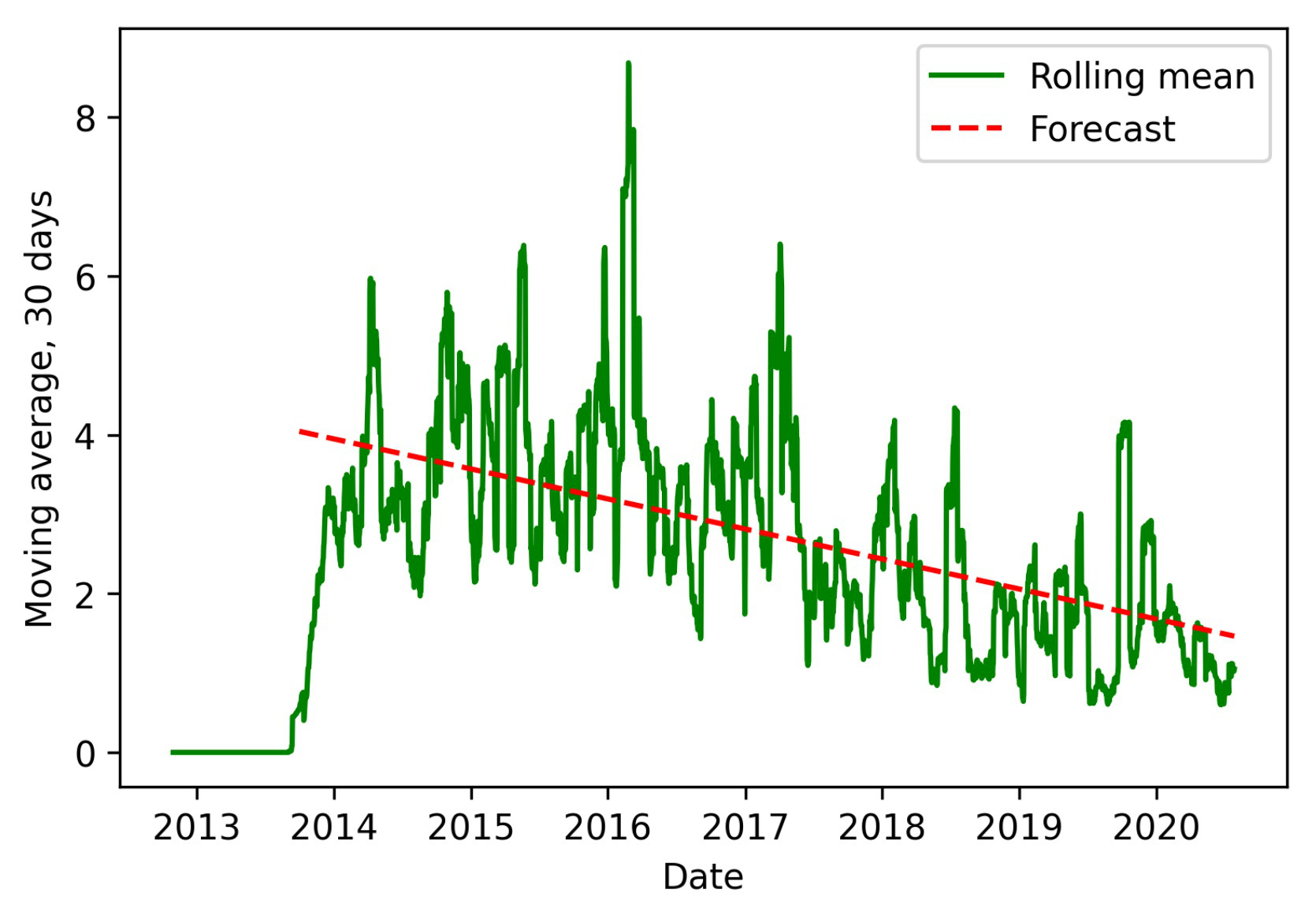
Best earner profits over the years
This case study proves that if you can produce unique content, you can have as much as a single image in your portfolio, to the contrary of hundreds or even thousands of images. In case you can have few unique pieces of content, they can substitute “the numbers game”.
Kaspars Grinvald’s case

Kaspar's portfolio (clickable)
Kaspars Grinvalds, who was interviewed at the Brutally Honest Stock Blog and earns around $4,200/month on 9,580 images at Shutterstock, Adobe Stock, iStock, Canva and 123RF. Pulling out my calculator these earnings amounts to an average of $2.28 / image / year, which is as good as it gets this day in age.
Other contributors reporting their earnings
Another interesting portal would be to check out some of the newer contributors’ YouTube channels where they report their monthly earnings and provide their insight into this challenging industry - I recommend the following:
Also might be interesting to check out Steve Heap’s earnings reports (since June 2011).
Earnings projections calculator
Back to the original question! It all depends on a multitude of factors with the most important being how much time you have to dedicate to the business and how unique and needed content you will produce.
Estimated industry level average is $0.08 / photo / month for all contributors for 2022 while a best-seller photo in Taras’ portfolio is $87.7 / photo / month. You can see there’s a literally over 1000 times difference between average and best-seller content! For example, Kaspars Grinvalds, mentioned above, makes about $0.18 / image / month, which is already more than x2 improvement over industry level. This is the key to understand microstock business: producing content that buyers actually need yields out of order results.
Earning per image per month = $
Size of portfolio =
Monthly earnings:
$
Adding some clips into the mix
Perhaps your main side-hustle is as a photographer but if you’re able to add some clips into the mix, then you’ll be well on your way to making a small side-income.
Even at a very modest average of 10 clips/month uploaded, this would eventually add to your overall earnings. Keep in mind that it often takes a little longer for clips to start selling than images and when they do the volumes tend to be lower.
As you can note from the Adam’s portfolio, the rate estimate is about $0.24 / clip / month on average, bringing you at least $60 / month after 2 years. Note that this is an estimate from the average video which will be higher if you will produce the right content. In fact, Xpiks blog has an excellent article on how to produce video content for microstocks.
Maximizing your earnings
Create only what the buyers need
It is tempting to produce content “what you can”, but in reality if you produce content that buyers need, your earnings will be higher than the average. Conversely, if you upload content that nobody needs, your earnings will be way below the average. How to know what buyers need? Check the in-depth guide in Xpiks blog.
Make sure to watch Adobe’s presentation on creating needed content:
Upload only to best-earnings agencies
Hopefully you haven’t been yet put off by all the negativity and perhaps do decide to proceed. As you can see above Steve and I focus our efforts to uploading our high-quality content to as many decent agencies as we possibly can in order to squeeze out as much out of every asset. For a comprehensive review of those top 10 agencies, see this blogpost.
However, you’ll likely find that 80% of your earnings initially will come from the top-four agencies, including: Shutterstock, Adobe Stock, iStockphoto and Alamy, probably in that order although the market is constantly changing.
Optimize your workflow
As you’ll be trying to run a side-business thinking about the amount of time you’re spending is fundamental. Your time spent on keywording and uploading is also a cost of producing your portfolio, although you might think initially that it “does not count”. Check this blogpost on how to do keywording optimally.
Fortunately, there are software out there that help you optimize your workflow, such as Xpiks. It can help not only to automatically suggest needed keywords, but also upload to all of the agencies you will ever need.
Reality check
This is not a get rich quick scheme! As you can see from the above results, during the first few years the ultimate goal should really be quite modest: to simply pay off your gear investments. My gear when I started cost me just over $3,000, such I’ve discussed above, which I managed to pay off after about three years.
This makes a logical conclusion that you should not quit your day job in the first three to four years to focus fully on the microstocks. Microstocks can be a great passive income, but it takes a good amount of time to build up (as pretty much with any job or investment). There are no magic shortcuts, but working consistently can bring you pleasant surprises few years down the road.
Header image from here.




